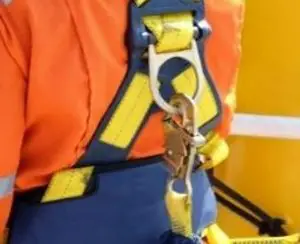Why do harnesses matter? Well, if you’re working at heights, a harness is your last line of defense against a fall. That’s why it’s important to know what materials your harness is made of and how they can affect your safety.
What are fall protection harnesses?
A fall protection harness consists of body support that helps to distribute the forces of a fall arrest evenly across the user’s body. The harness attaches to a lanyard, deceleration device, or other fall arrest device, and is usually donned by threading one’s arms through the shoulder straps and pulling the leg loops up over the hips. A properly fitting harness will snugly but comfortably encircle the wearer’s torso and upper thighs.
What materials are fall protection harnesses made of?
Most fall protection harnesses are made from one or more of the following materials: nylon, polyester, or Kevlar.
- Nylon is the most common material used in the construction of fall protection harnesses. It is strong, durable, and resistant to abrasion. It also has a good weight-to-strength ratio, meaning that it can support a lot of weight without being too heavy. Nylon is also comfortable to wear and has a low risk of skin irritation.
- Polyester is also a strong and durable synthetic fabric, but it is not as abrasion resistant as nylon. It is not as strong as nylon, but it is lighter and more comfortable to wear. Polyester is also less likely to shrink or stretch over time, so it can provide a more consistent fit.
- Kevlar: A synthetic fiber that’s five times stronger than steel, Kevlar is often used in bulletproof vests and military-grade body armor. It’s also becoming increasingly popular in fall protection harnesses due to its high level of strength and durability. However, they are also the most expensive and they can be uncomfortable to wear for long periods of time.
- Cotton is often used in fall protection harnesses because it is comfortable and breathable. However, cotton is not as strong as nylon or polyester and it can absorb moisture, which can make it uncomfortable to wear in humid or wet conditions. Cotton is often used in combination with other materials such as nylon or polyester.
How to choose the right fall protection harness
While fall protection harnesses may look similar, there are actually many different types made from a variety of materials. It’s important to choose the right harness for the job, as well as for the environment in which you’ll be working. Consider the following factors when making your selection:
- The type of work you’ll be doing: Are you working at heights? On a ladder? In a confined space? Each type of work has its own set of hazards, so it’s important to choose a harness that is specifically designed for the task at hand.
- The environment you’ll be working in: Will you be working indoors or outdoors? In hot or cold weather? In an area with high winds? Again, each environment has its own hazards that must be considered when choosing a fall protection harness.
- Your personal comfort: Will you be wearing the harness for long periods of time? Do you have any allergies or sensitivities that could be irritated by certain materials? Make sure to choose a comfortable harness that won’t cause any irritation or discomfort. Once you’ve considered all of these factors, you can narrow down your choices and select the right fall protection harness for the job.
Fall protection harnesses FAQs
Q: What types of materials are fall protection harnesses made of?
A: The most common type of material used in fall protection harnesses is polyester. There are also harnesses made from nylon, Kevlar, and other synthetic materials.
Conclusion
There are a variety of materials that harnesses can be made out of, each with its own advantages and disadvantages. The most important thing to look for in a harness is that it is comfortable and fits properly. Once you have found a harness that meets those criteria, you can then decide if you would prefer a harness made out of nylon, Kevlar, or another material.

